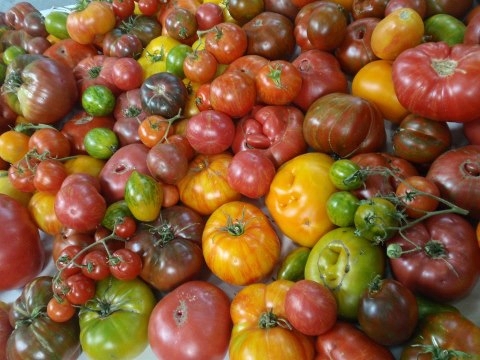
Tomatoes are relatively easy to grow. They sprint to maturity because they only have a few weeks of hot weather to produce their bounty. Examine the many varieties offered at farmers’ markets: heirlooms, hybrids, paste tomatoes, huge slicers and tomatoes in many different colors and shapes. Some weigh a pound or more, and some, like ‘Sungold,’ are small and prolific. Knowing the tomato plant’s requirements and monitoring closely will almost always produce good results and enough tomatoes for the neighbors.
Before planting, follow all directions on plant labels and read about tomatoes in Sunset’s Western Garden Book. The best guarantee of a healthy crop is soil well-amended soil with compost and a three-inch top dressing of well-aged manure.
Tomatoes need six to eight hours of sunlight a day and a consistent watering schedule. Watering deeply encourages deep roots. If the soil is amended, fertilizer isn’t necessary, but one or two feedings of a water-soluble fertilizer won’t hurt and may help. Too much nitrogen will produce lush foliage and few tomatoes.
Plants displaying holes or chewed leaves indicate that creatures are eating their daily meal. Snails chew tender leaves when plants are small, while the tomato worm likes to settle into the fruit. The large hornworm can consume large amounts of leaves and stems.
Common sense tells us to use pet-safe deterrents for snails. Hand-pick hornworms and put in the yard-waste bin. If you see whiteflies or aphids, blast them with strong jets of water.
Occasionally, one side of a plant will show leaf yellowing and sudden wilt. These are symptoms of fungal disease. Watering won’t help. Uproot the entire plant and place it in the yard-waste bin, not the compost pile. Fungal spores remain in the soil over the winter, so plant tomatoes in a different area the following season. Look for seedlings with a label that says “VFN resistant,” which indicates that the plant is resistant to verticilium wilt, fusarium (both fungal diseases) and nematodes.
Perhaps the most confusing and prevalent tomato problem is blossom-end rot. You’ve done everything right and your tomato plants look healthy. But when you pick the fruit, you notice a circle of sunken, hard brown skin on the blossom end. This damage, typically about the size of a fifty-cent piece, is a common problem. The cause is probably a lack of calcium due to inconsistent watering.
Water moves nutrients to feeder roots. You may have plenty of calcium in your soil, but if the soil is dry, the plant can’t get it. Plants need moist but not soggy soil. Too much water and the fruits may crack.
If we meet the tomato plant’s requirements, it will reward us with larger and more abundant fruit.
When the weather cools, you may still have unripe tomatoes. Dust thick slices of green tomatoes with seasoned flour and sauté them in a bit of bacon grease for two minutes per side.
Workshop: Napa County Master Gardeners will conduct a composting workshop in partnership with the City and County of Napa and Napa Recycling and Waste Services. The workshop is Saturday, September 7, at 9 a.m. at the Yountville Community Center. Learn how to turn your waste and kitchen scraps into wonderfully rich, free compost for your garden. Discover the basics of backyard composting, worm composting, and grasscycling. Register here: http://compost.naparecycles.org
Garden Tour: Napa County Master Gardeners will host a self-guided garden tour, “Down the Garden Path,” on Sunday, September 22, from 10 a.m. to 4 p.m. Visit seven unique gardens in and around downtown Napa, all maintained by Master Gardeners. Tickets: $25 advance/$30 day of event. For more information and to purchase tickets, visit http://ucanr.edu/ucmgnapa or call 707-253-4147. Find us on Facebook under UC Master Gardeners of Napa County.
Master Gardeners are volunteers who help the University of California reach the gardening public with home gardening information. Napa County Master Gardeners ( http://ucanr.org/ucmgnapa/) are available to answer gardening questions in person or by phone, Monday, Wednesday and Friday, 9 a.m. to Noon, at the U. C. Cooperative Extension office, 1710 Soscol Avenue, Suite 4, Napa, 707-253-4143, or from outside City of Napa toll-free at 877-279-3065. Or e-mail your garden questions by following the guidelines on our web site. Click on Napa, then on Have Garden Questions?